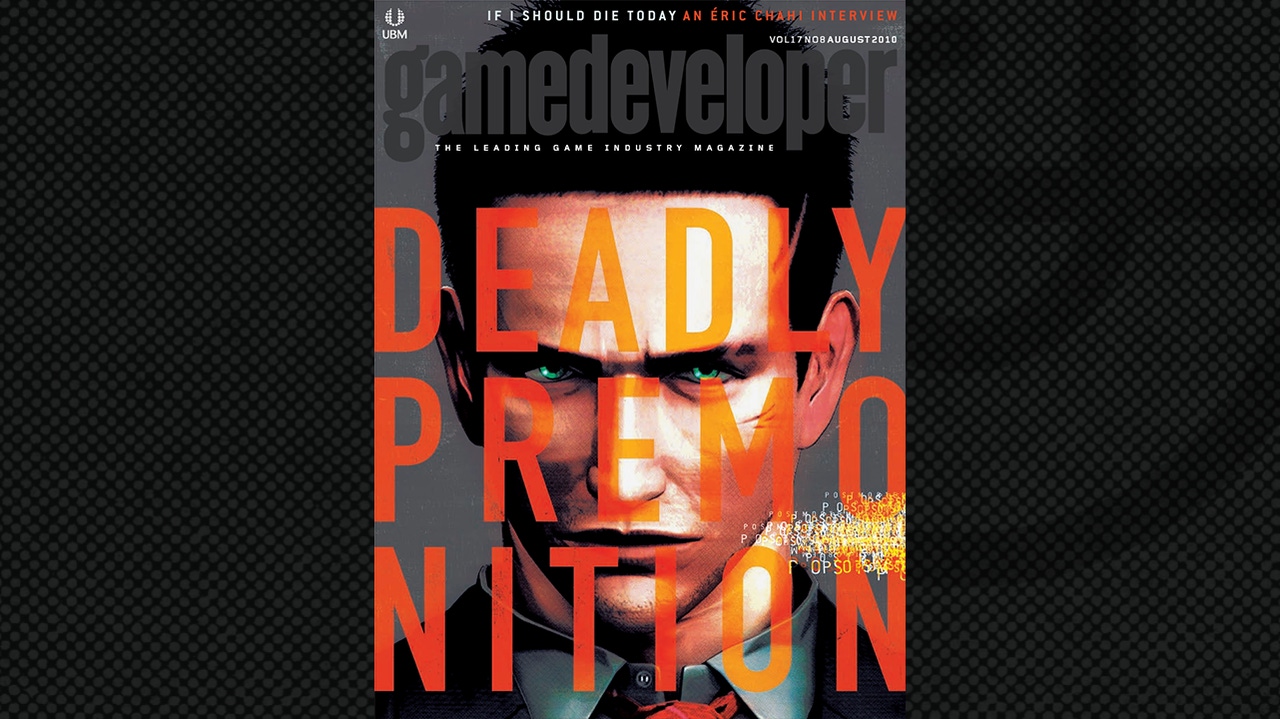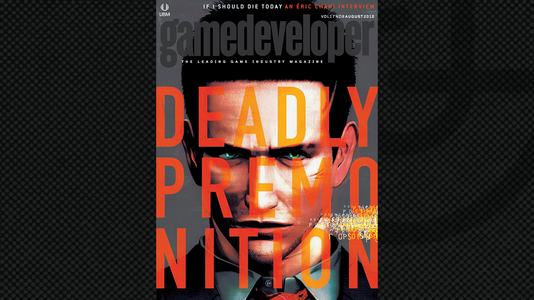
Image via Game Developer Magazine.
Deadly Premonition was released five years ago this month. This cult classic is an open world survival horror game interlaced with generous helpings of tongue-in-cheek humor and utter lunacy. Several members of the development team at Access Games contributed to this postmortem, which ran in the August 2010 issue of Game Developer Magazine. We are please to reprint it for the first time ever online.
Thanks to all of the developers who contributed: lead level artist Wataru Nishide, lead programmer Hideki Kataoka, programmer Yutaka Ohkawa, art director Hitoshi Okamoto, planner and audio manager Keiji Teranishi, and, of course, the game's writer and director, Hidetaka "SWERY" Suehiro.
This project began in the early fall of 2004. Looking back, it was more than five and a half years ago. After we released Spy Fiction in late 2003, Access Games wasn’t lucky enough to have the opportunity to work on another original title, and we wasted nearly a year deciding what our next game would be.
Of course, it’s possible we only received the chance to make such an uncommon game because we had so long to charge our batteries. The creativity that built up over so many months was about to explode, looking for an outlet to express itself. Our energy found an explosive release in the form of Marvelous Entertainment, and crystallized into what became Deadly Premonition.
Images via Game Developer Magazine, August 2010.
The process was logical, and you might say that we set out to follow a standard development course. But that course turned out to be more precipitous than we could have imagined, and it was, quite literally, a bloody few years. Numerous obstacles stood in our way: unclear nextgen console specs, the decision to go multi-platform, and the threat of project cancellation. It was all we could do to stand up to the hardships and remain steadfast in our implicit faith that the game would eventually be completed.
In the end, I learned that true effort is always rewarded. After pushing this project through, we found a gratifying reception waiting for us in a distant, foreign land.
What Went Right
1] CHARACTER BUILDING AND BACKSTORY (ESPECIALLY YORK AND ZACH) – SWERY (director) & Hitoshi Okamoto (art director)
We believe our greatest success in Deadly Premonition was the establishment of our main character. Many different types of protagonists have been created – and loved – in the history of videogames, so our primary mission was to devise a type of hero that had never existed before. Deadly Premonition is essentially a mystery, and although quality peripheral characters are crucial in good mysteries, the main character is especially important. I believe players pick up on the fact that while York may appear very handsome, he’s a true eccentric inside. York speaks his mind with no regard for the feelings of those around him while constantly muttering to himself … In other circumstances, it would be no surprise if players grew to dislike him, wondering “Who the hell is Zach?” [York has a second personality, named Zach, living within his mind. There is a strong argument to be made for Zach being “the player.” – ed.]
Yet everyone who plays the game seems to love him. Why? Perhaps it’s because players recognize that he’s extremely charming and reliable – a friend worthy of admiration. Of course, we don’t think we gained that recognition for free. There’s an important device at work: the invention of the “Zach as Player” relationship. Agent York pursues his murder investigation in Greenvale, the player munches popcorn in his living room, and Zach is the bridge between them.
You might say that the character we were aiming for is established the moment York and the player become true friends, joined through the conduit of Zach. Agent York is a character who only springs into existence with the assistance of the person playing the game … and that turned out to be exactly the new type of hero we were after.
We knew going in that a character created with the exclusion of the player just wouldn’t work. Please show York the same love you’ve given countless other video game characters before him. That’s all we – and he- can ask.
Images via Game Developer Magazine, August 2010.
2] STORY AND WORLDBUILDING (BOTH INITIALLY TOO EXTREME) – SWERY
We spent as much time polishing our storyline and worldview as we did our protagonist. During early development, our setting was much more urban and cynical than the final product. The presentation was also more violent, and decidedly more extreme; I think the one-year gap between original projects may have turned our thoughts toward violence. Our final world came together only after several iterations, and the overcoming of multiple near-cancellations. For the story, I kept as much sense of reality as possible while embellishing it with a somewhat dreamlike milieu. As a result, I believe the sections depicted as eality have a dreamlike feeling, and likewise, the actual dreams are given a sense of realism- we were able to smear the boundary line. There are very few video games so particular about depicting such things, and I think Deadly Premonition may have become a unique example among them.
"One might expect some talk about fabulous play control or revolutionary graphics. I can’t say either of those were particular successes in Deadly Premonition"
A realistic setting was also completely necessary for bringing this story to life. To build it, I posited three “reals:” “real time,” “real scale,” and “real life.” Implementing these with our limited budget and resources proved to be extremely difficult, but despite a great deal of resistance (even from within the team!), I felt these three concepts were essential.
First, to reproduce our five-square-mile town, we visited America for data collection, using measures to determine the width of roads, billboards, and railroad crossings. Second, to depict 24-hour time spans, we calculated weather patterns and the angle of the sun by giving our fictional town a real-world latitude. Finally, we wrote extremely detailed profiles for the townspeople (blood types, birthdays, favorite foods, favorite music, people they disliked, what age they were when they had their first kiss, etc.). While not necessary for the game proper, these were used to create individual 24-hour activity patterns for each character.
For example, when the punctual character Thomas rises in the morning, he goes to the toilet, washes his face, and brushes his teeth. If you have a moment while playing, try spying on his apartment- you’ll actually see Thomas performing these actions. Despite not appearing anywhere in the game, we even set the hourly wage for the A&G Diner (about $3.50 per hour, and $25-$30 per day, depending on tips). And, of course, every street in Greenvale has its own name. For a project as rash as this-replicating an entire rural American town from inside Japan- details like these were very important.
These factors layer and combine to form the town of Greenvale, and imbue Deadly Premonition with a sense of reality. This approach is particular to our team, and I wouldn’t necessarily recommend it to other developers … but should you get the chance, why not give it a try?
3] DISTINCTIVE MUSIC – Keiji Teranishi (planner)
Music was another focus in Deadly Premonition, and I feel our success in this area was worth the effort. The soundtrack served to further bolster our unique story and world; it may even strike a mood never before heard in games. Our unusual score owes a great deal to our success in helping the composers appreciate the unique aesthetic behind the game. We showed them countless design documents, played music we thought would fit, and sometimes even hummed song ideas – efforts that resulted in the musicians’ understanding of the work.
Doing our utmost to convey the game’s aesthetic caused the town of Greenvale to take shape in the minds of our sound team. By the time its citizens began living their daily lives inside our composers’ heads, the melodies of Greenvale were created almost automatically … or so it seemed to me! As proof, I submit “Life Is Beautiful,” a memorable whistling tune that conjures up the feel of a peaceful country stroll, and “York And Zach,” a song that plays during monologues representing the mysterious image of our hero. Both initial demos were given the okay almost immediately, and both were easily worked into the game. I can think of no other songs that match the worldview of Deadly Premonition so perfectly.
Several other tracks, however, were created only through much trial and error. Particularly difficult were “Red Tree,” a theme representing madness heard in the Red Room at the outset of the game, and “Miss Stiletto Heels,” Carol’s song, which might be considered Deadly Premonition’s second theme. We were extremely specific about our orders for these tracks – not only for the arrangements, sound levels, and effects, but also aspects as minute as the timing of hi-hats within single bars! The lunatic improvisational section in “Red Tree” also went through numerous takes with different instruments and arrangements before being judged complete.
In the end, I believe Deadly Premonition’s music succeeded in adding depth to our unique world and characters. If I were a greedy man, I might say that having a few more tracks would have made it even better!
Images via Game Developer Magazine, August 2010.
4] CASTING AND VOICEOVER – Keiji Teranishi
I feel that the voice work in Deadly Premonition was even more successful than the music. We spent two weeks recording at WebTone Studios, which was in San Jose at the time (the studio has since relocated to Los Angeles). Over 6,000 total lines needed to be recorded, including pre-loaded and streaming samples. That meant we had to get approximately 500 lines in the can every day. Two weeks may seem like a long time, but Access Games is located in Japan, so it was absolutely imperative we lock down everything required in the time allotted. The pressure was extraordinary.
We spent those two weeks completely sequestered in the studio … but like Agent York himself, we were also becoming familiar with a new town as we shuttled back and forth from our hotel. These experiences proved invaluable after returning to Japan, so one might say the San Jose trip allowed us to kill two birds with one stone.
Before recording began, we showed our actors images of the characters to help create their roles. Although we recorded only after explaining in detail other aspects like the general tone, personalities, and family relationships (Greenvale is full of eccentrics with more than a few quirks), directing the performances turned out to be quite a task. When he had difficulty getting his point across, SWERY occasionally gave direct instructions by getting in the booth and performing lines himself.
Among all our fine voices, one actor performed his role exactly as we imagined … and perhaps even better: Mr. Jeff Kramer as York. Jeff brought even greater depth and style to the lead role than Access Games had envisioned, for which we are deeply grateful. Despite having only five days to record some 3,000 lines (he was the lead, after all!), Jeff presented us with a truly brilliant performance.
Of course, each of the actors portraying Greenvale’s vibrant characters – George, Emily, Thomas and the rest – turned in wonderful performances. If the fans who play Deadly Premonition get a sense that our characters might be real people living their lives somewhere, then our casting was indeed a success.
5] OUR LOVE AND PASSION FOR DEADLY PREMONITION – SWERY
In trying to compile “Five Rights,” one might expect some talk about fabulous play control or revolutionary graphics. I can’t say either of those were particular successes in Deadly Premonition, so I don’t think such topics would be appropriate for our fifth “Right.”
After much internal debate, I came to the conclusion that Deadly Premonition’s greatest “Right” is the fact that we poured our love into the game. That really says it all, so I’m going to use this space to touch on a few aspects we were particularly obsessive about. I hope this text gives you some idea of how much we cared about our game, and indeed how wasteful some of our efforts may have seemed.
Side Missions. I was insistent that the content of our side missions always draw upon aspects of the NPCs’ personalities, thus adding further depth to the world of the game. We built the missions so that players who pursued them might learn more about the personalities and lives of our characters – aspects not revealed in the main story.
Observation And York’s Monologues. Examining certain items in
No tags.





































